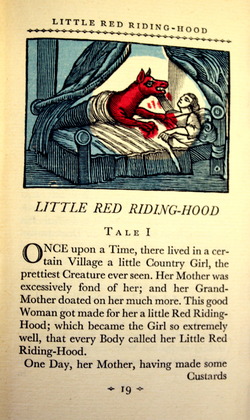Little Red Riding Hood
In Perrault’s version of ‘Little Red Riding Hood’, reproduced here in a 1925 edition of Mother Goose, the heroine exhibits a willingness to be seduced, setting a precedent for the tale as analogous to the wickedness of female sexuality being a deservedly punishable instinct. It is Perrault who added the motif of the ‘chaperon rouge’, marking the child with the colour of Satan and harlotry, as well as being a signifier of burgeoning adolescence by alluding to menstruation. It is through her own naïveté and stupidity that she is tricked by the wolf and eaten/raped, the same fate which befalls her grandmother. Unlike the majority of Little Red Riding Hood tales which precede it, in Perrault’s version the heroine does not out-wit the wolf or survive- instead she is dealt the punishment of rape or death, one it is implied she deserves for consorting with strange men, represented by the wolf. In short, female sexual urges are condemned as sinful, and hold dire consequences.




